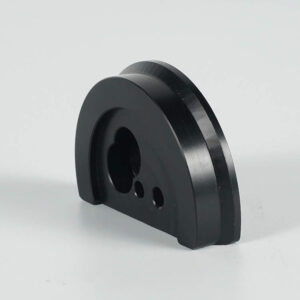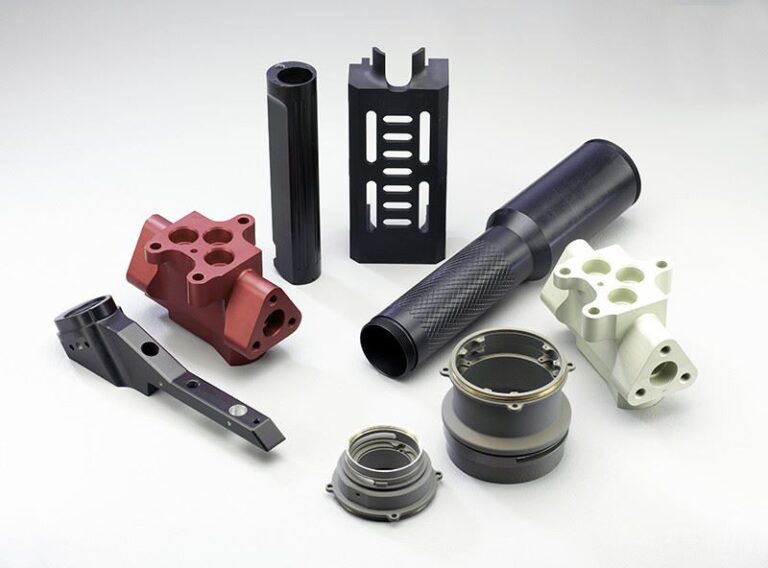Maybe you want your custom-made aluminum bicycle pedals to be a beautiful shade of blue, or the threaded fasteners you’re having turned more durable. Perhaps you’re wondering how to keep the 4140 steel brackets you’re ordering free of rust. These are but a few examples of how we can help you make sheet metal and CNC machined parts perform better, make them more wear- and corrosion-resistant, and improve parts’ overall appearance, by using various finishing options. These options, covered in this design tip, include: plating, anodizing, Polishing, powder coating, painting, and passivation.
Plating
For those of you needing a durable, corrosion- and wear-resistant finish, suitable for a wide variety of materials, look no further than nickel plating.
bright nickel plating—is applied by negatively charging a workpiece after submersion in a tank of electrolyte. Current is applied to a series of nickel anodes within the tank, slowly releasing nickel ions that migrate through the solution and bond themselves to the part.As its name implies, bright nickel is shiny.
Depending on the amount of current applied and time spent in the tank, thickness can range from 0.00005 in. to 0.001 in. (0.00127mm to 0.0254mm). Electroless nickel plating eliminates the need for electrical contact and the subsequent electrical flow just described. For this reason, it’s a favorite for high-volume plating of fasteners, fittings, and other hardware items. It is also very useful for hard to reach interior areas as it plates evenly all over the part. It can be applied to almost any substrate: steel, stainless steel, aluminum, brass, and others.
The electroplating process just described can be applied to Zinc, Tin, Gold, Silver as well. Exchange the nickel anodes for ones made of zinc, for example, and you’re left with a plating that’s great at protecting iron and steel from corrosion. Zinc should not, however, be used where parts will see temperatures greater than 500 degrees F or in marine environments.
Due to its low cost, tin plating is also quite common. It is a soft, ductile, silvery-white metal that is not only corrosion-resistant but quite agreeable to soldering, so it is often used in the electronics industry for computer chassis and other components.
Then there are gold and silver plating options. From an electronics industry perspective, both are similar to tin, albeit with higher conductivity, solderabililty, and corrosion resistance, with a higher price to match.These and other metals may require that a “nickel strike” is applied to the surface before plating to improve adhesion. Nickel plating provides excellent adhesion properties, so it is often used as an “undercoat” for other coatings.
Anodizing
Anodizing is one of the most commonly performed of all finishing options. Often referred to as a plating operation, it’s technically an electrochemical conversion process that creates a thin oxide film on a metal part’s surface.
Two types of aluminum anodizing are available. Chromic Acid anodize (Type I) provides a whisper-thin but still durable coating, typically between 0.00002 in. and 0.0001 in. (0.00127mm and 0.00254mm) thick. It is gray in appearance but can be dyed a dull, non-reflective black. It’s commonly used for welded parts and assemblies, and as a primer before painting. Like all anodized surfaces, it is non-conductive.


Harder yet is Type II Sulfuric Acid anodize, also known as decorative anodizing for its ability to absorb practically any color dye. That said, it offers an exceedingly durable finish up to 0.001 in. (0.0254mm) thick that is also quite attractive. Everything from carabiner hooks and flashlight handles to motorcycle parts and hydraulic valve bodies can be Type II anodized.
As mentioned, the anodizing of titanium components is also a possibility. In the medical industry, titanium medical devices are commonly anodized for color-coding purposes. In aerospace applications, titanium parts are anodized for increased corrosion resistance.
With some exceptions, parts are usually sealed immediately after anodizing in a bath of nickel acetate or hot deionized water, closing off the material’s microscopic pores. This process also generates different performance characteristics such as improved bonding and lubricity, depending on the type of anodizing and sealing process used.
Powder Coating or Painting
Powder coating for sheet metal parts is another popular option.This option works by spraying a polymer-based colored powder through a special gun that charges the individual paint particles as they pass, making them stick to the surface. The powder-coated part is then placed into a hot oven to cure.
Powder coating is thicker than traditional wet paint and is more durable and fade-resistant as well. It’s also better for the environment—any leftover powder can be reclaimed and reused, and there are no smelly VOCs (volatile organic compounds) to contend with like there is with paint. For parts that can’t resist the heat of the curing process, however, or ones that require a thinner coating than powder coat provides, paint is an excellent alternative.
In either case, we offer dozens of color choices and sheens. Paint and powder coat alike can be made glossy, flat, matte, or anything in between.
Passivation
Passivating is a process that “converts” the outer surface of metals to an exceedingly thin layer of oxide. It is similar in this respect to anodizing, but it’s use is far more widespread, is applicable to a wide variety of metals, and is mostly performed without electricity.
Stainless steel is passivated to further reduce any chance of corrosion and remove any stray iron from machining operations.
Polishing
Polishing, also known as buffing, a process of rubbing the surface of parts or utilizing a chemical action to produce a smooth and shiny surface, make the surface get significant specular reflection or reduce diffuse reflection in some materials.
